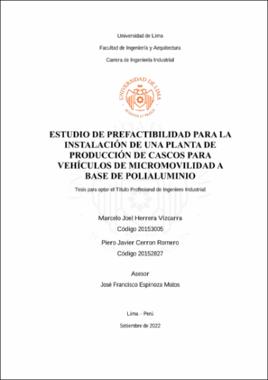Estudio de prefactibilidad para la instalación de una planta de producción de cascos para vehículos de micromovilidad a base de polialuminio

Ver/
Tesis
(application/pdf: 1.984Mb)
(application/pdf: 1.984Mb)
Autorización
(application/pdf: 466.8Kb)
(application/pdf: 466.8Kb)
Autorización
(application/pdf: 418.7Kb)
(application/pdf: 418.7Kb)
Reporte de similitud
(application/pdf: 34.80Mb)
(application/pdf: 34.80Mb)
Fecha
2022Asesor(es)
Metadatos
Mostrar el registro completo del ítemResumen
La pandemia de COVID-19 ha generado un incremento en el uso de vehículos de
micromovilidad como de bicicletas, scooters, patines y skates; los cuales, ya no solo
cumplen un rol de entretenimiento, sino que también ahora son usados con mayor
frecuencia como medios de transporte. Esto debido a que, al movilizarse en estos
vehículos, se evita el contacto con otras personas y, por ende, la transmisión del virus.
Adicional a ello, muchas personas también optan por movilizarse en estos vehículos ya
sea para evitar el tráfico vehicular, para mantenerse ejercitados y/o por el hecho de ser
vehículos que no contaminan el medio ambiente.
A raíz de esta necesidad y de la nueva ley que declara el uso obligatorio de casco
de protección para los usuarios que usen estos vehículos, se propone fabricar cascos que
cuenten con un material aglomerado en su carcasa exterior (polialuminio), el cual se
obtiene a partir del reciclaje de envases tetrapak y el cual genera que el producto final sea
altamente resistente y a la vez más ligero y cómodo que los productos del mercado.
El presente trabajo de investigación consistirá en determinar la viabilidad del
proyecto, para lo cual, se evaluará su desarrollo en ocho capítulos. El primero, consiste
en el desarrollo de los objetivos, justificaciones e hipótesis. El segundo, detalla el estudio
de mercado para la determinación de la demanda del proyecto. El tercero evalúa los
factores de microlocalización y macrolocalización para la ubicación de la planta. El
cuarto, determina el tamaño de planta de acuerdo a los recursos, demanda y tecnología.
El quinto describe las tecnologías a usar, proceso de producción y se halla la disposición
de planta. El sexto representa la estructura organizacional de la empresa. Y en los dos
últimos se determinan las inversiones, el presupuesto y la evaluación social del proyecto.
Al final de los ocho capítulos, se presentan las conclusiones y recomendaciones
del proyecto de investigación para la retroalimentación de los hallazgos conseguidos. The COVID-19 pandemic has generated an increase in the use of micromobility vehicles
such as bicycles, scooters, roller blades and skateboards, which no longer only play an
entertainment role, but are also now used more frequently as means of transportation.
This is because, when moving in these vehicles, contact with other people is avoided and,
therefore, the transmission of the virus. In addition to this, many people also choose to
get around in these vehicles, either to avoid vehicular traffic, to stay exercised and/or
because they are vehicles that do not pollute the environment.
As a result of this need and the new law that declares the mandatory use of a
protective helmet for users who use these vehicles, it is proposed to manufacture helmets
that have an agglomerated material in their outer shell (polyaluminum), which is obtained
from the recycling of tetrapak containers and which generates that the final product is
highly resistant and at the same time lighter and more comfortable than the products on
the market.
This research work will consist in determining the viability and feasibility of the
project, for which, its development will be evaluated in six chapters. The first consists of
the explanation of the objectives, development of the justifications and the statement of
the hypotheses. The second details the market study to determine the demand for the
project and the commercial strategy for positioning the product. The third assesses the
micro-location and macro-location factors to determine the best location for the plant.
The fourth, determines the size of the plant according to resources, demand and
technology. The fifth describes the technologies to be used, the production process and
the plant layout. And the sixth represents the organizational structure of the company.
At the end of the six chapters, the conclusions and recommendations of the
research project are presented for feedback on the findings.
Cómo citar
Herrera Vizcarra, M. J. & Cerron Romero, P. J. (2022). Estudio de prefactibilidad para la instalación de una planta de producción de cascos para vehículos de micromovilidad a base de polialuminio [Tesis para optar el Título Profesional de Ingeniero Industrial, Universidad de Lima]. Repositorio institucional de la Universidad de Lima. https://hdl.handle.net/20.500.12724/17173Editor
Universidad de LimaTemas
Coleccion(es)
- Tesis [1167]
El ítem tiene asociados los siguientes ficheros de licencia:

